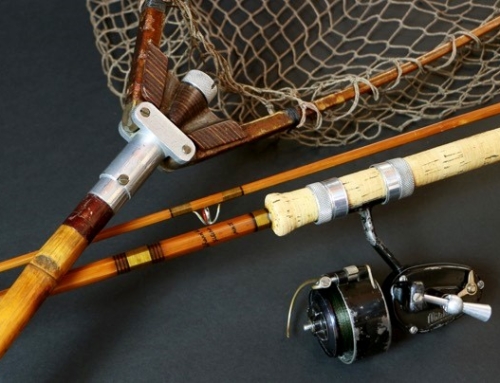Want to know what your old antique tackle’s Worth?
Want to start your own vintage fishing tackle collection?
Then read the article and watch the videos 1 thru 4. They’ll give you a head start in the exciting world of vintage fishing tackle collecting.
“Get Your Old Tackle Out!” and my article ‘Starting a Vintage Tackle Collection’ will not only give you a financial insight into what’s hot and what’s not but will also give you a good idea of values and the recent prices paid at some of the top auction houses.
If you want to start a collection or think you may have an item of old tackle that could be worth a fortune, you can’t afford to miss… Get Your Old Tackle Out! and my article ‘Starting a Vintage Tackle Collection’
Happy Hunting!
Get Your Old Tackle Out Episodes 1, 2, 3 and 4
Starting a Vintage Tackle Collection
By Chris Sandford.
Who knows what forgotten item of old tackle might be lurking in your garden shed or in that cupboard under the stairs? Finding a long forgotten rod or reel, might even encourage you to start a collection and join the happy band of enthusiasts like myself who haunt the tackle auctions and car boot sales in the hope of finding a great rarity.
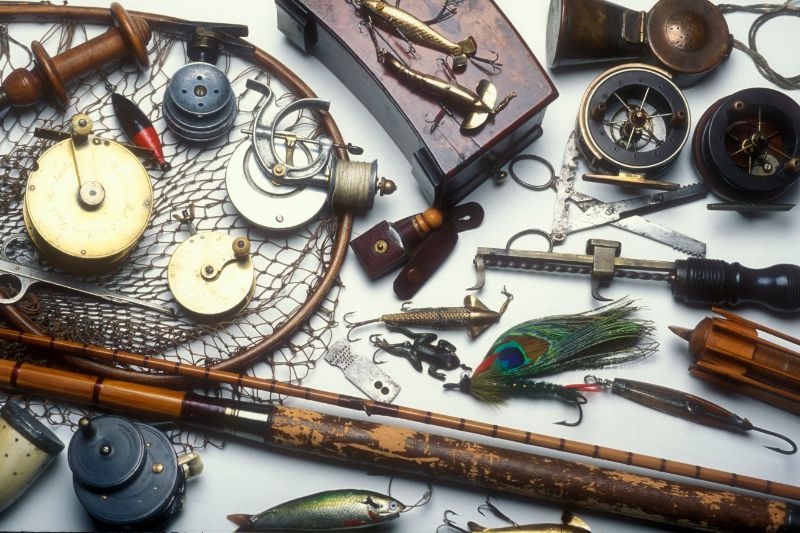
Collecting Vintage Tackle
Collecting vintage tackle falls into 3 general categories. Firstly, there is the ‘A little bit of everything’ collector. Then there is the specialist who concentrates on one specific area or in some cases, a singular maker. Finally, there is the angler who just likes a few vintage items about his person!
Collectors come from all the angling persuasions.
Some start their angling journey by learning the art of casting a fly line or, in my case, trotting a float in the hope of a large Chub. So, when I’m asked the best way to start a collection, I always suggest an item from the angler’s past. In most cases this will not be expensive and can ease the new collector into a fascinating hobby without breaking the bank.
My First Vintage Rod and Reel

Here is my first acquisition, purchased some 30 years ago. I stopped fishing in my teens and did not rediscover angling until my late forties. My first nostalgic purchase was a Richard Walker Mk IV Carp rod and a half bale Mitchell reel, the same combination on which Walker caught his then record Carp, in 1952. These two items cost me £75, today, in auction; they would make at least £250. Not that I would ever part with them you understand!
Now, let’s say you are a new collector and you have successfully purchased some old tackle that reminds you of those carefree childhood days, but now fancy a few items that carry a little more history and perhaps, some interesting provenance. I should warn you at this point that you are now stepping onto the slippery slope, and there is absolutely no hope for you!
Collecting Vintage Brass Reels
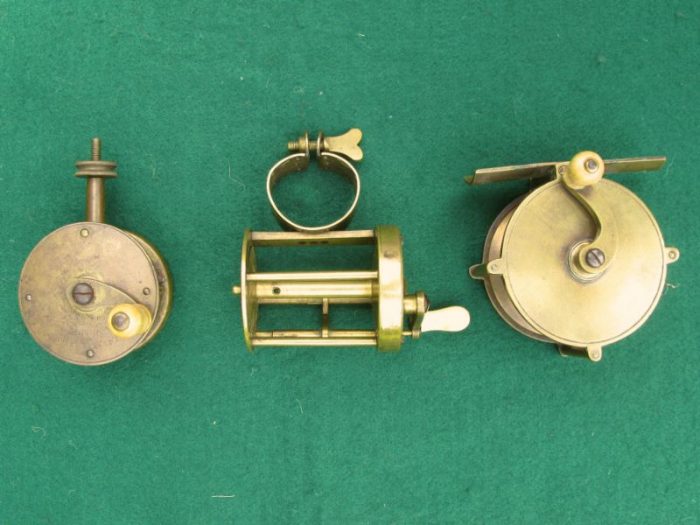
Compared to later reels by well-known manufactures, early brass reels or winches as they were known, can still be picked up at a reasonable price.
The first reels of this kind were known as ‘spike’ winches, *(Left) so called, because a threaded spike on the bridge of the reel went through a hole in the butt of the rod and was secured with a nut.
The next development was the ‘collar’ winch. *(Centre) This gave anglers the freedom to move the reel up or down the rod to suit their preference. Many of these reels were also multipliers, but didn’t gain great popularity because the mechanism, built mostly by watchmakers, was not strong enough to handle a large fish. Finally the reel ‘seat’ *(Right) became commonplace and still serves us well today. A maker’s name and/or beautifully inscribed decoration can increase the value of any of these early reels by at least 100%.
Collecting Vintage Wooden Reels
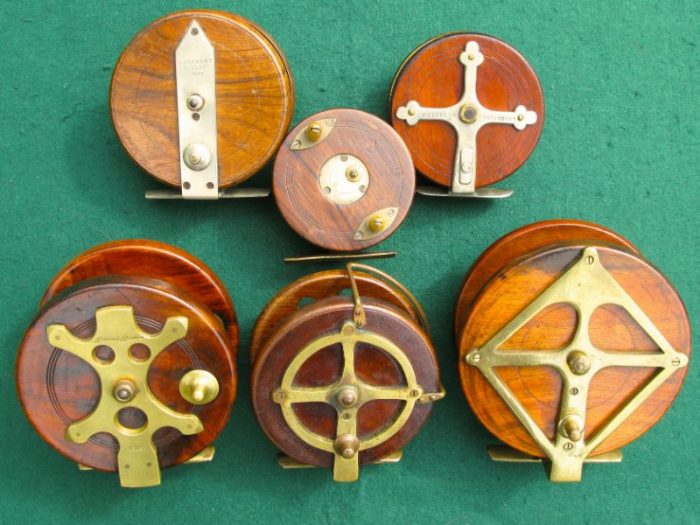
The most collectable maker is without doubt David Slater of Newark. His reputation for carefully choosing the wood and then waiting until it was perfectly seasoned, guaranteed that his reels never warped and were therefore a sound investment. Here are three examples of his work. Left: An early ‘strap back’ made of nickel silver. Centre: A small ‘Nottingham’ reel with what became known as the Slater ‘latch’ for easy removal of the spool. Right: An ornate nickel silver ‘starback’ probably made to order as very few of this pattern have been discovered.
Large sea reels had a problem with salt water causing them to warp. Three examples here give you a good idea of how various makers strengthened them against the rigours of the ocean! From left to right. A ‘circle’ back, a ‘frog’ back and a ‘kite’ back. All very collectable, but be sure that you not only have some strong shelving but also promise to do the dusting!
Collecting Vintage Aerial Reels
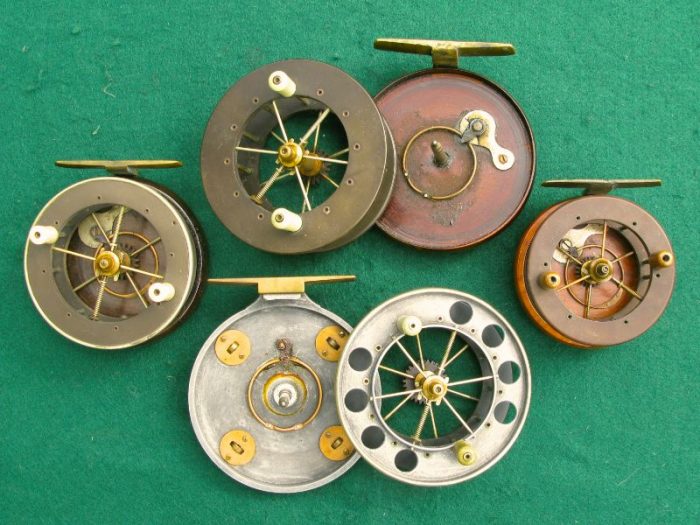
I wonder if Henry Coxon had any idea in 1896, that he was to be responsible for designing one of the milestones in the history of angling equipment. Allcock & Co. were not slow to take up his reel design with its ultra light drum and spoked frame, and the now famous ‘Coxon Aerial’ was born. When wood was no longer used in the construction of the backplate and aluminium took its place, the reel was renamed the ‘Allcock Aerial’ and the rest, as they say, is history.
There are so many variations that we still find un-catalogued models. A number of these have turned up over the last few years, as two leading collections have gone under the hammer. Rare models have been snapped up, so top prices are not what they were. In fact if you’re considering starting an Aerial collection…now’s the time! Here are three examples from my collection, the details of which might help you with identification.
Top centre is the classic ‘Coxon Aerial’. On the left, a 4 spoke Coxon bound in German silver. On the right, a super rare, 3 spoke Coxon. Finally bottom centre, the much sought after ‘Roller Back’ Allcock Aerial. The salesmen must have had a field day with this one. You can just imagine…”We highly recommend this model Sir. Should a really large fish attach itself to your line, these carefully placed rollers will help the reel take the strain and I’m sure will stop it over heating”
Don’t you just love old fishing tackle?!
Collecting Fly Tying Memorabilia
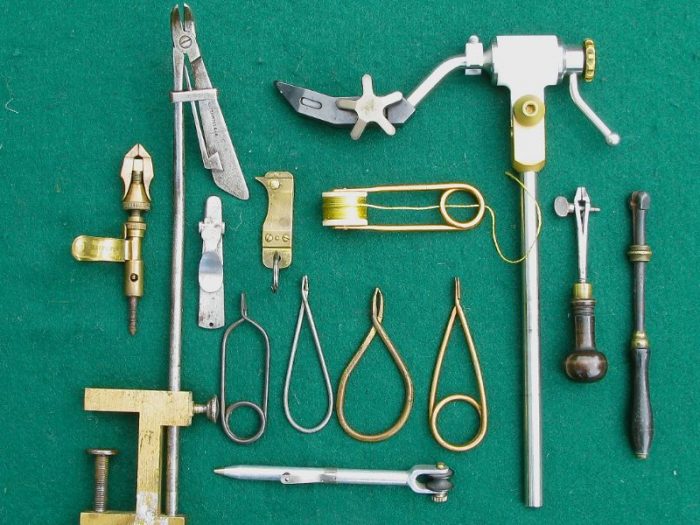
Over the last 10 years I’ve collected some of the more interesting items connected with fly tying, and frankly, quite a few of the really silly ones as well!
So here is a selection of rare fly trying collectables that can still be found at reasonable prices.
Starting on the left of our picture is a ‘thumb’ vice (Circa 1908). Next to it is the ‘Holtzapffel’ vice (Circa 1910). Holtzapffel was the talented lathe maker and engineer who designed one of the first commercially available fly tying vices and a number of specialist fly tying tools. His hackle pliers and hook threader are on the right of the vice.
Next to them, an early Veniard bobbin holder, and below them, various old hackle pliers. At the bottom of the picture, the highly collectable 1935 ‘Lightening Fly Dresser’. A pencil shaped bobbin holder with a convenient built-in brake for thread control! On the far right are two rare hand vices and, standing out like a sore thumb, is my very modern, but highly collectable, Waldron Law Vice. Since production of this wonderful vice stopped a few years ago, they have become the most sought after modern fly tying collectable.
After record prices being paid on eBay, I am reliably informed that there is a long waiting list of tyers willing to pay between £1,500 and £2,000! The original cost was around £450… Not a bad investment!
Collecting Vintage Fishing Lures
Ahhh, the lure of the lure! Like many other collectors, I like a little bit of everything.
But back in the early 90’s, I had a deep and meaningful obsession with the history of British baits. I was the sad researcher covered in cobwebs in a corner of the British Library! The result of my labours is my book, ‘The Best of British Baits’ published in 1997. It covers the history of our baits from Izaac Walton’s Silk Minnow, through to the 1930’s.
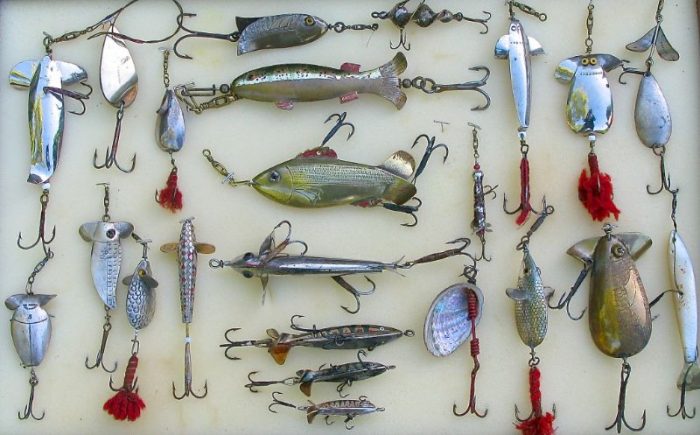
Here is a display of mixed lures that will give you some idea of the vast range of examples that are available to the keen collector. Sadly my insurance company insist that the more valuable examples are kept in the bank. Who was to know that many lures that cost just a few pounds in the 80’s and 90’s are now worth hundreds? The big names to look for are, Gregory, Geen, Allcock and Hardy, and any example with glass eyes, is good news!
Collecting Antique Gaffs and Gadgets.
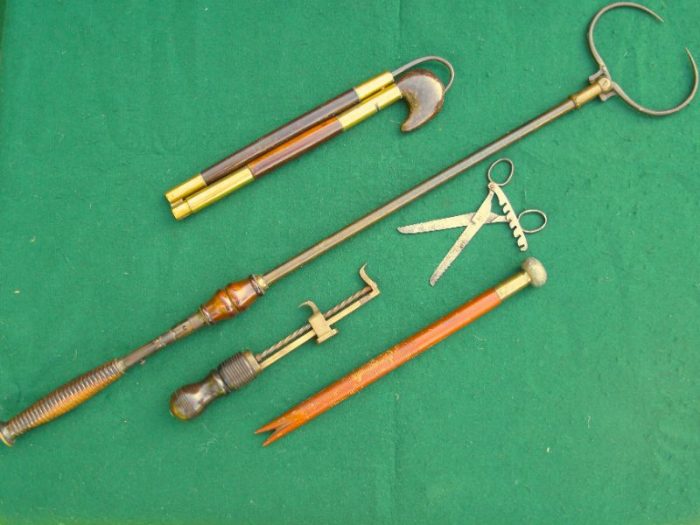
This category covers a positive plethora of fascinating collectables. The diabolical two hook gaff in the centre of our shot was designed and patented by a Mr F. Cook on
28th March 1891. Presumably, Mr Cook lost a very large fish and locked himself away until he came up with this horrendous implement. One primes the device by pulling back the wooden collar on the shaft. A small trigger behind the collar releases the hooks over the hapless fish.
The little wooden gaff above Mr Cook’s creation is a folding poacher’s gaff. Just the right size to secrete down one’s trouser leg!
The Jardine Pike Gag (Below the Cook’s Gaff) is one of those much sought-after items that rarely come to auction. Patented in 1896, the Farlows catalogue of 1909 tells us that the price was 8/6d plus 3d postage and that ‘…. by turning the handle, the mouth of the fish can be distended to any width required’
I don’t suppose that it crossed anyone’s mind that two sets of trebles were probably enough pointed objects in a Pike’s mouth!
The simplest of objects for disgorging and despatching fish was, Allcock’s ‘Conway’ Pike ‘stunner’ and disgorger. (Bottom) It was basically a fork-ended cosh, but sold for a very reasonable 2/9d!
Our forefathers invented a fine array of jaw-prising, hook-removing and cranium-coshing apparatus. The most eminently sensible of these are without doubt, pike scissors.
(Above the Jardine Gag) ‘The Modern Angler’ by Otter (1898) sings their praises, in part, as follows. ‘….The gag is kept open by way of a steel extender, the teeth of which are made to catch on a screw; but when not in use, this portion shuts up on one limb of the gag. The pike gag can also be used as scissors, being very strong, and sharpened for the purpose.
Collecting Vintage Threadline Reels.
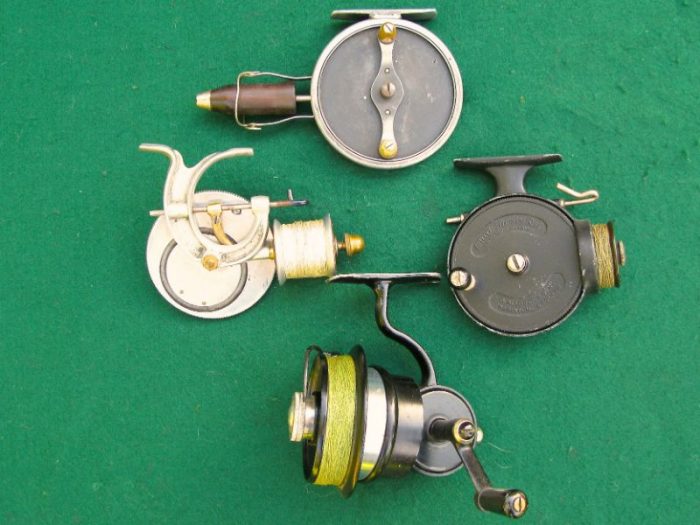
The threadline revolution began on May 4th 1905, when Alfred Holden Illingworth patented his now famous, Illingworth No.1 reel. (Top)
It is believed that Illingworth got his idea by studying the silk weaver’s shuttle and decided that there was no good reason why a reel could not be made with the spool permanently facing forward. With the addition of a fine silk line, a small spinner could now be cast further and more accurately than ever before.
The reel was an immediate success but, ‘new technology’ will always have its critics, and Illingworth was the subject of heated debate and criticism from those of a more traditional persuasion. In reply to their complaints, Illingworth wrote that he hoped the reel would be ‘…used sparingly and with the discretion which the sportsman-like instinct of a fly fisherman would dictate.’ He added that he only used the reel himself at low water to ‘…rid the stream of marauding and retrograde old trout’!
Illingworth produced another 4 models, but they were expensive so were not available to the angler of modest means. But help was on the way! The story goes, that when engineer Walter Stanley was repairing an Illingworth No.1, he had an idea for a more robust reel that would not be beyond the pocket of the average angler. He patented his brainchild in 1926 and christened it, ‘The Flyer Threadline’. (Left Centre) He had the good sense to take his idea to Allcock & Co in the early 1930s. They recognized the potential, redesigned the reel, and brought ‘The Allcock Stanley’ to the market at the bargain price of 22/6d. (Centre Right) It was an immediate success and sold in its thousands. Although designed for light float fishing, reports of it landing large salmon and pike soon enhanced its reputation.
Most early fixed spool reels had a big problem with line ‘bedding in’. Either the spool or the line guide went back and forth to help spread the line, but a hard pull from a large fish could well signal trouble.
In 1935, PW Felton came up with an answer to this problem. (Bottom) He built his ‘Crosswind’ reel with a tilting spool so as it oscillated; it laid the line across itself at an angle. There were six models incorporating this successful concept, all manufactured by Allcock and Co.
In 1936 Felton sealed the reel’s reputation by winning four major prizes in the Crystal Palace Casting Championships.
As a new member of the SPS I was fascinated to read in our Spring 2013 issue of Sussex Piscator that PW Felton was elected as the secretary of our Trout section in 1928. Now there’s a man I would like to have met!
If you have an interest in this area of collecting, John Stephenson’s book ‘Understanding Threadlines’ is essential reading. Sadly it’s now out of print but can be found on the Internet for between £20-£30.
Collecting Carved and Stuffed Fish
I have a few stuffed and a couple of carved fish in my collection, but nothing as sensational as the examples that have gone through Angling Auctions hands in the recent past.
Company boss Neil Freeman allowed me access to his substantial library.

The first fish I chose was this exceptionally rare carved wooden Rainbow (Kamloops) Trout by Tommy Brayshaw. (1886 -1967) The nickel silvered plaque reads “Rainbow Trout, Caught at Jewel Lake, British Columbia by J.H. Moller, Weight 18lbs, June 10th 1932” The black and white photograph attached to the bottom left corner shows the angler holding the fish, with Jewel Lake in the background. Estimated at £5,000-£8,000 it made a startling £18,000!
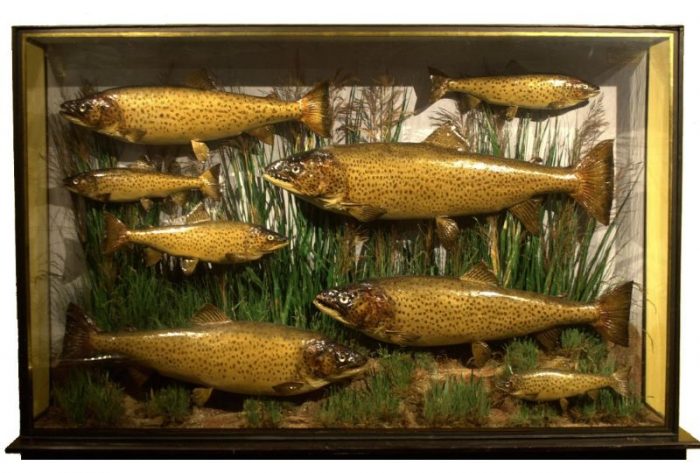
My second choice was one of a pair of rare J. Cooper & Sons cabinets containing eight mounted Brown Trout caught by the Earl of Coventry. The label in the top left corner reads, “Irish Lough Trout taken by The Earl of Coventry, June 1879”. Estimated at £6,000-£9,000, the pair of cases sold for
£16,000 plus the buyer’s premium…. A snip!
The message here is a simple one. Fine quality and sound provenance cost money! But there are still plenty of cased and carved fish out there, that won’t break the bank.
Collecting Vintage Rods
There is no doubt that vintage rods are the ‘poor relation’ of angling collectables. This is because few collectors have the wall space to display them and unless kept away from central heating and a damp atmosphere, the condition of a rod will usually degrade far quicker than a reel from the same era.
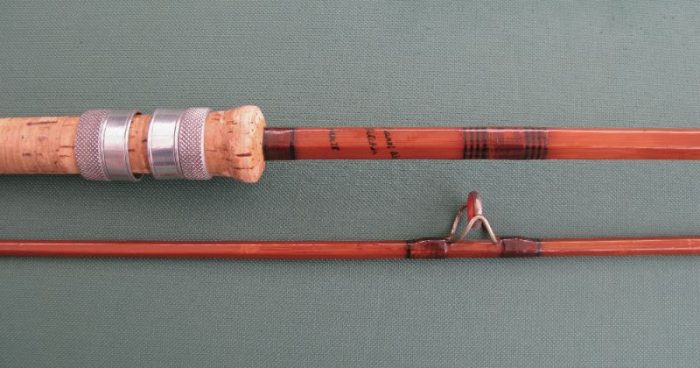
Over the last few years, coarse rods made by B.James of Ealing have held their prices well, especially those bearing Richard Walkers’ name. I was recently fortunate enough to obtain the rod on which the great man landed the 1952 record Carp ‘Clarissa’.
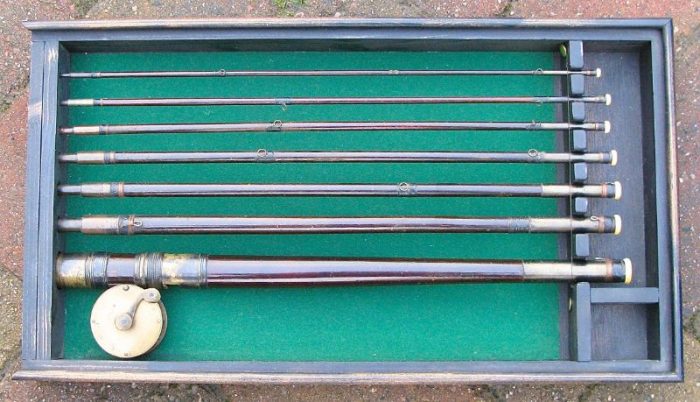
Multi piece examples like this seven-piece valise rod by Holroyd of London (1815-1911) with its brass folding handle reel, will always sell well because not only does it have a good provenance, but makes an attractive addition to any collection in a small display frame.
I hope you’ve found this brief visit to the world of vintage tackle collecting of interest. Although some collectors are inclined to think that they own all the tackle in their collections, I prefer to believe that we are simply preserving it for future generations. If you fancy starting a collection, happy hunting and remember….It’s still out there…it just needs finding!
